Official Pace Car of the 1961 Indianapolis 500 Race
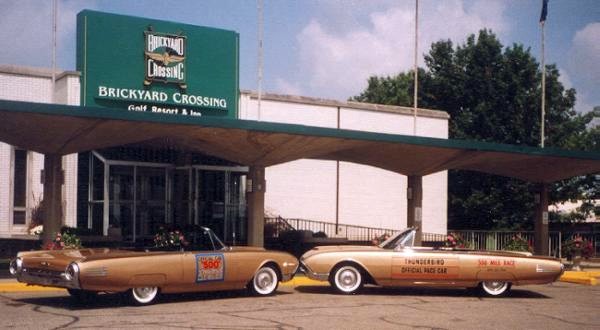
Unmistakably new...unmistakably Thunderbird for 1961: Pace Car of the Indy 500 Race
Above left: one of the 32 Official "500" Festival cars restored with correct graphics on the door.
Above right: another Official "500" Festival car restored with Official Pace Car graphics.
(This photograph was taken in front of the Brickyard Crossing Golf Resort & Inn, located on the grounds of the Indianapolis Motor Speedway, during the 1999 VTCI Meet.)
OFFICIAL PACE CAR AND ALTERNATE PACE CAR
Ford Motor Company was given the honor of providing the Pace Car for the
1961 Indianapolis 500 Mile Race. The Thunderbird, with its unmistakably
new styling was the obvious choice. This would be the 50th (Golden) Anniversary
of the Indianapolis 500 Race, although it was not actually the 50th running
of the race; during World War II the race was suspended. Ford would provide
a total of thirty-four 1961 Thunderbird Convertibles, including one Official Pace Car, one alternate Official Pace Car, and thirty-two Official "500"
Festival Cars.
All would be painted a unique shade of Gold that was not available on any other car, not even other Thunderbirds. All of the cars featured White convertible tops and either Black Leather or Black Vinyl interior trim, Firestone brand whitewall tires (they sponsored the race), Rear Fender Shields, and 3.00:1 Rear Axles.
The Official Pace Car differed from the others in that it was equipped with a Light Pearl Beige Leather interior. This car had specific markings on it that identified it as the Official Pace Car. These included "THUNDERBIRD OFFICIAL PACE CAR" lettering on the doors in black block lettering, with "Thunderbird" above the crease on the door, and "Official Pace Car" below the crease. "Thunderbird" was also in slightly larger lettering. Below "Official Pace Car" were two 1/2-inch wide horizontal red stripes running the full length of the door. On the rear quarter panel, centered high above the rear wheel opening, were the words "GOLDEN ANNIVERSARY" in small black block lettering. At the crease, "INDIANAPOLIS MOTOR SPEEDWAY" appeared with "MAY 30, 1961" just above the rear wheel opening in matching lettering. The alternate Official Pace Car would serve as a backup, in case the Official Pace Car developed mechanical problems that would prevent it from operating to begin the race. The alternate car was identical except it had a black interior. Mechanical modifications to the two Pace Cars might have been made prior to the race, but no documentation has turned up to date indicating this actually happened.
All would be painted a unique shade of Gold that was not available on any other car, not even other Thunderbirds. All of the cars featured White convertible tops and either Black Leather or Black Vinyl interior trim, Firestone brand whitewall tires (they sponsored the race), Rear Fender Shields, and 3.00:1 Rear Axles.
The Official Pace Car differed from the others in that it was equipped with a Light Pearl Beige Leather interior. This car had specific markings on it that identified it as the Official Pace Car. These included "THUNDERBIRD OFFICIAL PACE CAR" lettering on the doors in black block lettering, with "Thunderbird" above the crease on the door, and "Official Pace Car" below the crease. "Thunderbird" was also in slightly larger lettering. Below "Official Pace Car" were two 1/2-inch wide horizontal red stripes running the full length of the door. On the rear quarter panel, centered high above the rear wheel opening, were the words "GOLDEN ANNIVERSARY" in small black block lettering. At the crease, "INDIANAPOLIS MOTOR SPEEDWAY" appeared with "MAY 30, 1961" just above the rear wheel opening in matching lettering. The alternate Official Pace Car would serve as a backup, in case the Official Pace Car developed mechanical problems that would prevent it from operating to begin the race. The alternate car was identical except it had a black interior. Mechanical modifications to the two Pace Cars might have been made prior to the race, but no documentation has turned up to date indicating this actually happened.
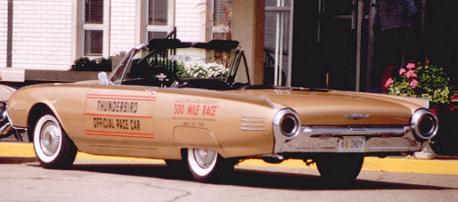
THE OFFICIAL "500" FESTIVAL CARS
The 32 festival cars filled their official capacity by appearing in the
parade the week before the race, and to carry the race car drivers around
the track during introductions held before the race. The 32 festival cars
plus the alternate Pace Car represented the 33 drivers that would start
the race. These festival cars all featured Black Leather or Black Vinyl
interiors. Specific markings appeared to identify these cars, including
a large blue square frame about an inch wide, the center of which was clear
and displayed "OFFICIAL CAR" in large black block letters at
the center top of the door. Below, "500" appeared in large red
numerals, just above the crease on the door. "FESTIVAL" in black
script outlined in white was just below the crease, and below that "MAY
30, 1961" again in black lettering with a white outline. On the rear
quarter panels, centered above the rear wheel opening and above the bodyside
crease appeared "COURTESY OF" in black script, followed by the
name of the Ford dealership sponsoring that particular car in black block
lettering just below the bodyside crease. After performing their duties
at the race, these 32 festival cars were returned to the sponsoring dealers
who, in turn, probably sold them. They might have been repainted due to
the decals that had been affixed to them—or in order to sell them—and
the fact they once held a special place in automotive history was quickly
forgotten.
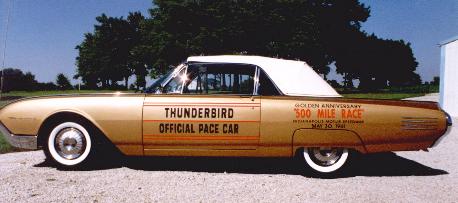
HOW TO IDENTIFY THE INDY 500 CARS
Of the 34 cars, only 6 have been located and documented over the years.
The Official Pace Car is believed to have been given to A.J. Foyt as part
of his winnings, and some believe he in turn later gave the car to his
Mother, but this is speculation, no one seems to know for sure. To date
no documentation has turned up that sheds any light on the history of the
car after the race. However, Automotive Mileposts is attempting to determine
what happened to the Pace Car after the race, and when we are able to document
those events, they will be included on this page.
Unfortunately, one of the 6 documented cars was destroyed in a devastating fire at the Wisconsin Dells in December 1999. The remains of the car apparently still exist, and due to the extremely unique nature of the car, the possibility exists that it might be rebuilt someday. Two of the surviving cars are in Indiana, one is in Wisconsin, one in Arkansas, and the final one is believed to be in Iowa.
For unknown reasons, the survival rate of the 1961 Thunderbirds as a whole seems to be very low. However, the possibility exists that the identity of a few unknown surviving Indy 500 cars might be obscured by repaints using another color. Here are a few facts that will enable you to identify these cars:
Unfortunately, one of the 6 documented cars was destroyed in a devastating fire at the Wisconsin Dells in December 1999. The remains of the car apparently still exist, and due to the extremely unique nature of the car, the possibility exists that it might be rebuilt someday. Two of the surviving cars are in Indiana, one is in Wisconsin, one in Arkansas, and the final one is believed to be in Iowa.
For unknown reasons, the survival rate of the 1961 Thunderbirds as a whole seems to be very low. However, the possibility exists that the identity of a few unknown surviving Indy 500 cars might be obscured by repaints using another color. Here are a few facts that will enable you to identify these cars:
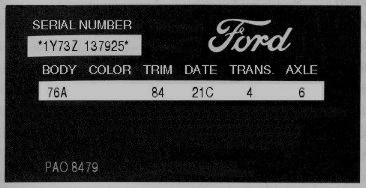
A representation of the 1961 Thunderbird VIN plate appears above; actual
plates have additional markings on them which have been removed in this
example for clarity.
WHAT TO LOOK FOR:
1. Serial numbers within the range of 1Y73Z 137925 to 1Y73Z 137976.
2. Space for color code on plate is blank.
3. Trim code of 56, 84, or 86.
4. Date code of 21C.
5. "PAO 8479" stamped on plate near bottom.
(This is the pre-approved order number for the Indy 500 cars.)
6. Additional aluminum tags have been found located under radiator supports and windshield washer bags on Indy 500 cars being restored. One bears the serial number in the upper left corner, with the notation "J 56949" near the bottom. Another lists: "PAO 8479 SPECIAL PAINT RINSHEDMASON J 56949"
These numbers identify the Pre-Approved Order (PAO 8479) as well as the paint manufacturer's code for the special Gold paint used on these cars.
A third plate features a series of numbers that identify the dealer sponsoring that particular car in the race. The series of numbers in the lower left corner of the tag will contain the number "34", which is the District Code for Indianapolis, where the cars were delivered.
2. Space for color code on plate is blank.
3. Trim code of 56, 84, or 86.
4. Date code of 21C.
5. "PAO 8479" stamped on plate near bottom.
(This is the pre-approved order number for the Indy 500 cars.)
6. Additional aluminum tags have been found located under radiator supports and windshield washer bags on Indy 500 cars being restored. One bears the serial number in the upper left corner, with the notation "J 56949" near the bottom. Another lists: "PAO 8479 SPECIAL PAINT RINSHEDMASON J 56949"
These numbers identify the Pre-Approved Order (PAO 8479) as well as the paint manufacturer's code for the special Gold paint used on these cars.
A third plate features a series of numbers that identify the dealer sponsoring that particular car in the race. The series of numbers in the lower left corner of the tag will contain the number "34", which is the District Code for Indianapolis, where the cars were delivered.
Additional examples of the aluminum tags used on the Indy 500 cars are
being prepared, and will be added in this space in the future.
Facts About the Indianapolis Motor Speedway
The Indianapolis 500 Track was built in 1909, with a surface made of crushed
stone and tar on top of which 3.2 million paving bricks were placed for
the track surface. By the late 1940's, everything except the main straightaway
was paved with asphalt; following the race in 1961, this section was also
paved with asphalt during the month of October. The banking and dimensions
of the track today are essentially the same as when the track was built.
The first Indianapolis 500 Race was held in 1911, and won by Ray Harroun driving a Marmon at an average speed of 74.602 mph. The prize money totaled $14,250 that year.
With over 250,000 permanent seats the Indianapolis Motor Speedway is the world's largest seating facility. All that remains visible of the original 3.2 million bricks is the 36-inch "Yard of Bricks" at the start/finish line.
The first Indianapolis 500 Race was held in 1911, and won by Ray Harroun driving a Marmon at an average speed of 74.602 mph. The prize money totaled $14,250 that year.
With over 250,000 permanent seats the Indianapolis Motor Speedway is the world's largest seating facility. All that remains visible of the original 3.2 million bricks is the 36-inch "Yard of Bricks" at the start/finish line.
Track Specifications
Length of Track: 2 1/2 miles (13,200 feet) measured three feet
above the inside edge of the white line
Straightaways: 2 Long at 5/8-mile each (3,300 feet)
2 Short at 1/8-mile each (660 feet)
Corners: 4 at 1/4-mile each (1,320 feet)
Corner Banking: 9 degrees, 12 minutes
Straightaway Width: 50 feet
Corner Width: 60 feet
Pit Area: 2,175 feet
Infield Acreage: 224 acres
Speedway Acreage: 559 acres
Pace Car Duties
Other than being the most photographed car in the race, the Pace Car leads the field for two ceremonial laps and one official lap that brings it to the green flag at 11:00 AM. Sam Hanks drove the Thunderbird Pace Car at the 1961 Indy 500 Race. Hanks also drove the Pace Car in 1958-1960, as well as 1962-1963.
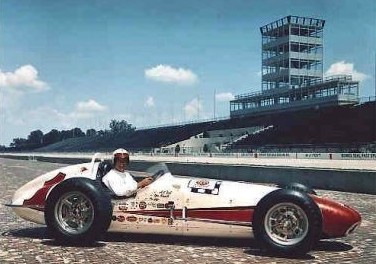 The 1961 Indianapolis 500 Race
The 1961 Indianapolis 500 Race
Winner: A.J. Foyt, Jr. (Holds record for Most
Career Starts 1958-1992; Career
Times Led: 38; Career Miles Led: 12,272 1/2)
Starting Position: 7
Car Number: 1
Car Name/Sponsor: Bignotti/Bowes Seal Fast
Qualifying Speed: 145.900 (for comparison,
Juan Montoya qualified for the
2000 Indy 500 with a speed of 223.372)
Time: 3:35:37.490
Average Speed: 139.130
Chassis/Engine: Trevis/Offy I-4
Laps Completed: 200
Laps Led: 71
Prize Money: $117,975
The 1961 Indy 500 Race was the first time a rear-engine car competed in the race; finishing 9th, it was driven by Formula One veteran Jack Brabham.
Length of Track: 2 1/2 miles (13,200 feet) measured three feet
above the inside edge of the white line
Straightaways: 2 Long at 5/8-mile each (3,300 feet)
2 Short at 1/8-mile each (660 feet)
Corners: 4 at 1/4-mile each (1,320 feet)
Corner Banking: 9 degrees, 12 minutes
Straightaway Width: 50 feet
Corner Width: 60 feet
Pit Area: 2,175 feet
Infield Acreage: 224 acres
Speedway Acreage: 559 acres
Pace Car Duties
Other than being the most photographed car in the race, the Pace Car leads the field for two ceremonial laps and one official lap that brings it to the green flag at 11:00 AM. Sam Hanks drove the Thunderbird Pace Car at the 1961 Indy 500 Race. Hanks also drove the Pace Car in 1958-1960, as well as 1962-1963.
 The 1961 Indianapolis 500 Race
The 1961 Indianapolis 500 RaceWinner: A.J. Foyt, Jr. (Holds record for Most
Career Starts 1958-1992; Career
Times Led: 38; Career Miles Led: 12,272 1/2)
Starting Position: 7
Car Number: 1
Car Name/Sponsor: Bignotti/Bowes Seal Fast
Qualifying Speed: 145.900 (for comparison,
Juan Montoya qualified for the
2000 Indy 500 with a speed of 223.372)
Time: 3:35:37.490
Average Speed: 139.130
Chassis/Engine: Trevis/Offy I-4
Laps Completed: 200
Laps Led: 71
Prize Money: $117,975
The 1961 Indy 500 Race was the first time a rear-engine car competed in the race; finishing 9th, it was driven by Formula One veteran Jack Brabham.
A Word of Thanks...
We would like to thank Mike Sercer, President of the Vintage Thunderbird Club of Indiana, and Tim Natarus for allowing us to feature their beautifully restored 1961 Thunderbird Convertibles. Both were 1961 Indianapolis 500 Official cars, and participated in the festivities. The photo taken of their two cars is likely the first time since the 1961 Race that two of these cars have been photographed together at the Speedway. Both of these gentlemen went out of their way to make this feature possible. We are sincerely grateful.
Car with Pace Car graphics owned by Mike Sercer
Car with "500" Festival graphics owned by Tim Natarus
We would like to thank Mike Sercer, President of the Vintage Thunderbird Club of Indiana, and Tim Natarus for allowing us to feature their beautifully restored 1961 Thunderbird Convertibles. Both were 1961 Indianapolis 500 Official cars, and participated in the festivities. The photo taken of their two cars is likely the first time since the 1961 Race that two of these cars have been photographed together at the Speedway. Both of these gentlemen went out of their way to make this feature possible. We are sincerely grateful.
Car with Pace Car graphics owned by Mike Sercer
Car with "500" Festival graphics owned by Tim Natarus